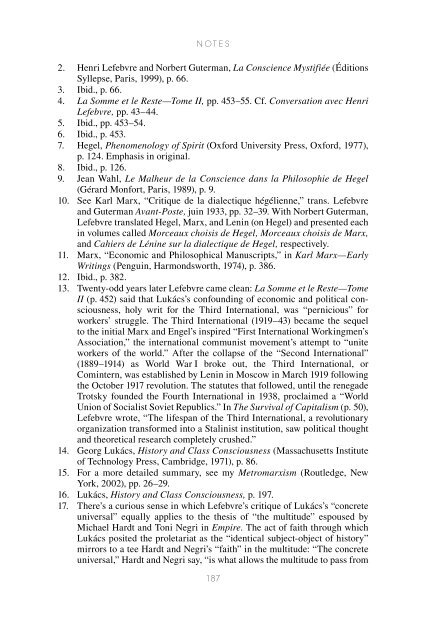Henri Lefebvre: A Critical Introduction - autonomous learning
Henri Lefebvre: A Critical Introduction - autonomous learning
Henri Lefebvre: A Critical Introduction - autonomous learning
Create successful ePaper yourself
Turn your PDF publications into a flip-book with our unique Google optimized e-Paper software.
n o t e s<br />
2. <strong>Henri</strong> <strong>Lefebvre</strong> and Norbert Guterman, La Conscience Mystifiée (Éditions<br />
Syllepse, Paris, 1999), p. 66.<br />
3. Ibid., p. 66.<br />
4. La Somme et le Reste—Tome II, pp. 453–55. Cf. Conversation avec <strong>Henri</strong><br />
<strong>Lefebvre</strong>, pp. 43–44.<br />
5. Ibid., pp. 453–54.<br />
6. Ibid., p. 453.<br />
7. Hegel, Phenomenology of Spirit (Oxford University Press, Oxford, 1977),<br />
p. 124. Emphasis in original.<br />
8. Ibid., p. 126.<br />
9. Jean Wahl, Le Malheur de la Conscience dans la Philosophie de Hegel<br />
(Gérard Monfort, Paris, 1989), p. 9.<br />
10. See Karl Marx, “Critique de la dialectique hégélienne,” trans. <strong>Lefebvre</strong><br />
and Guterman Avant-Poste, juin 1933, pp. 32–39. With Norbert Guterman,<br />
<strong>Lefebvre</strong> translated Hegel, Marx, and Lenin (on Hegel) and presented each<br />
in volumes called Morceaux choisis de Hegel, Morceaux choisis de Marx,<br />
and Cahiers de Lénine sur la dialectique de Hegel, respectively.<br />
11. Marx, “Economic and Philosophical Manuscripts,” in Karl Marx—Early<br />
Writings (Penguin, Harmondsworth, 1974), p. 386.<br />
12. Ibid., p. 382.<br />
13. Twenty-odd years later <strong>Lefebvre</strong> came clean: La Somme et le Reste—Tome<br />
II (p. 452) said that Lukács’s confounding of economic and political consciousness,<br />
holy writ for the Third International, was “pernicious” for<br />
workers’ struggle. The Third International (1919–43) became the sequel<br />
to the initial Marx and Engel’s inspired “First International Workingmen’s<br />
Association,” the international communist movement’s attempt to “unite<br />
workers of the world.” After the collapse of the “Second International”<br />
(1889–1914) as World War I broke out, the Third International, or<br />
Comintern, was established by Lenin in Moscow in March 1919 following<br />
the October 1917 revolution. The statutes that followed, until the renegade<br />
Trotsky founded the Fourth International in 1938, proclaimed a “World<br />
Union of Socialist Soviet Republics.” In The Survival of Capitalism (p. 50),<br />
<strong>Lefebvre</strong> wrote, “The lifespan of the Third International, a revolutionary<br />
organization transformed into a Stalinist institution, saw political thought<br />
and theoretical research completely crushed.”<br />
14. Georg Lukács, History and Class Consciousness (Massachusetts Institute<br />
of Technology Press, Cambridge, 1971), p. 86.<br />
15. For a more detailed summary, see my Metromarxism (Routledge, New<br />
York, 2002), pp. 26–29.<br />
16. Lukács, History and Class Consciousness, p. 197.<br />
17. There’s a curious sense in which <strong>Lefebvre</strong>’s critique of Lukács’s “concrete<br />
universal” equally applies to the thesis of “the multitude” espoused by<br />
Michael Hardt and Toni Negri in Empire. The act of faith through which<br />
Lukács posited the proletariat as the “identical subject-object of history”<br />
mirrors to a tee Hardt and Negri’s “faith” in the multitude: “The concrete<br />
universal,” Hardt and Negri say, “is what allows the multitude to pass from<br />
1 7
















